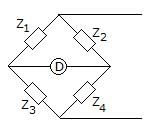Test: AC Bridges - GATE MCQ
25 Questions MCQ Test - Test: AC Bridges
In figure, Z1 = 200∠60° Ω, Z2 = 400∠ - 90° Ω, Z3 = 300∠0°. Then Z4 for the bridge to be balanced is


The main advantage of Owen’s bridge for measurement of unknown inductance is that
The advantage of Hay’s bridge over Maxwell’s inductance–capacitance bridge is that
Under balanced condition of a bridge for measuring unknown impedance, if the detector is suddenly taken out
Maxwell’s inductance-capacitance bridge is used for measurement of inductance of :
The advantage of Hay’s bridge over Maxwell’s inductance-capacitance bridge is because
The Wien’s bridges are suitable for the measurement of the frequency of the range of
For single frequency value, the most sensitive detector is ________.
Commonly used balance detectors for AC bridges are headphones, tuned amplifiers, and vibration galvanometers.















